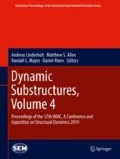Abstract
The process stability of a metal cutting operation is determined by the dynamic compliance behavior of the machine components lying within the force flux. This not only includes the cutting tool and the machine tool structure but also the workpiece. The problem of predicting the tool tip frequency response function (FRF) of a tool in a clamped state has been addressed in the literature using experimental dynamic substructuring. However, the problem of predicting the compliance behavior of a point on a workpiece, which is clamped on a machine table, has not yet been addressed comprehensively.
In case of a milling machine, workpieces are often clamped using bolted joints or fixtures. In this paper, an efficient method for coupling a milling workpiece to a machining table is proposed using experimental-analytical substructure coupling techniques such that, an FRF at any point on the clamped workpiece can be predicted. This FRF can then be utilized for predicting process stability.
In the proposed method, the dynamic behavior of the workpiece is simulated using a discretized model and that of the table is measured experimentally. The accurate measurement of the experimental model of the table is essential for successful substructure coupling. This includes the measurement of translational as well as rotational compliances at the coupling points. For overcoming the challenge of the measurement of rotational compliances, an alternative method using decoupling is proposed and compared with several relevant experimental techniques from the literature. Additionally, a sensitivity analysis is carried out in order to identify the most relevant compliances necessary for an accurate prediction of the dynamics in clamped state. Based on these results, a guideline for successful coupling of workpieces or fixtures with a machining table are proposed. The proposed method is implemented and validated for a workpiece clamped to a milling machine table using bolted joints.
Access this chapter
Tax calculation will be finalised at checkout
Purchases are for personal use only
References
Brecher, C., Weck, M.: Werkzeugmaschinen Fertigungssysteme 2, Textbook, vol. 9 (2017)
Altintas, Y.: Manufacturing Automation: Principles of Metal Cutting, Machine Tool Vibrations and CNC Design. Cambridge University Press, Cambridge (2000)
Schmitz, T.L., Duncan, G.S.: Three-component receptance coupling substructure analysis for tool point dynamics prediction. J. Manuf. Sci. Eng. 127, 781 (2005)
Park, S.S., Altintas, Y., Movahhedy, M.: Receptance coupling for end mills. Int. J. Mach. Tools Manuf. 43(9), 889–896 (2003)
Albertelli, P., Goletti, M., Monno, M.: An improved receptance coupling substructure analysis to predict chatter free high speed cutting conditions. Procedia CIRP. 12, 19–24 (2013)
Brecher, C., Chavan, P., Fey, M., Daniels, M.: A modal parameter approach for receptance coupling of tools. MM Sci. J. 2016, 1032–1034 (2016)
Schmitz, T.L., Burns, T.: Receptance coupling for high-speed dynamics prediction. In: Proceedings of the 21st International Modal Analysis Conference (IMAC-2003), Kissimmee, FL (2003)
Ertürk, A., Özgüven, H.N., Budak, E.: Analytical modeling of spindle–tool dynamics on machine tools using Timoshenko beam model and receptance coupling for the prediction of tool point FRF. Int. J. Mach. Tools Manuf. 46(15), 1901–1912 (2006)
Li, H., Xue, G., Zhou, Y., Li, H., Wen, B.: Receptance coupling for frequency response prediction of cylindrical workpiece in CNC lathe. J. Vibroeng. 17(4), 1731–1747 (2015)
Honeycutt, A., Schmitz, T.: Receptance coupling model for variable dynamics in fixed-free thin rib machining. Procedia Manuf. 26, 173–180 (2018)
Tuysuz, O., Altintas, Y.: Frequency domain updating of thin-walled workpiece dynamics using reduced order substructuring method in machining. J. Manuf. Sci. Eng. 139(7), 071013 (2017)
Law, M., Rentzsch, H., Ihlenfeld, S.: Predicting mobile machine tool dynamics by experimental dynamic substructuring. Int. J. Mach. Tools Manuf. 108, 127–134 (2016)
Daniels, M.: Substrukturkopplung zur effizienten Schwingungsanalyse von Werkzeugmaschinen, Dissertation. Apprimus Verlag, Aachen (2017)
Klerk, D., Rixen, D., Jong, J.: The frequency based substructuring method reformulated according to the dual domain decomposition method. In: Conference: Proceedings of the XXIV International Modal Analysis Conference (2006)
Klerk, D., Rixen, D., Voormeeren, S.: General framework for dynamic substructuring: history, review, and classification of techniques. AIAA J. 46, 1169–1181 (2008). https://doi.org/10.2514/1.33274
Craig, R.R., Kurdila, A.J.: Fundamentals of Structural Dynamics, 2nd edn. Wiley, Hoboken (2006)
Duarte, M., Ewins, D.: Rotational degrees of freedom for structural coupling analysis via finite-difference technique with residual compensation. Mech. Syst. Signal Process. 14(2), 205–227 (2000)
Ewins, D.: Modal Testing: Theory, Practice and Application, 2nd edn. Research Studies Press, Baldock and Philadelphia (2000)
Acknowledgements
The authors wish to gratefully acknowledge the support of the German Research Foundation (DFG). This work was funded as part of the DFG Project “Experimental substructure coupling for vibration analysis in machine tools” (Project Number-BR 2905/55-2).
Author information
Authors and Affiliations
Corresponding author
Editor information
Editors and Affiliations
Rights and permissions
Copyright information
© 2020 Society for Experimental Mechanics, Inc.
About this paper
Cite this paper
Chavan, P., Brecher, C., Fey, M., Loba, M. (2020). Workpiece Coupling in Machine Tools Using Experimental-Analytical Dynamic Substructuring. In: Linderholt, A., Allen, M., Mayes, R., Rixen, D. (eds) Dynamic Substructures, Volume 4. Conference Proceedings of the Society for Experimental Mechanics Series. Springer, Cham. https://doi.org/10.1007/978-3-030-12184-6_5
Download citation
DOI: https://doi.org/10.1007/978-3-030-12184-6_5
Published:
Publisher Name: Springer, Cham
Print ISBN: 978-3-030-12183-9
Online ISBN: 978-3-030-12184-6
eBook Packages: EngineeringEngineering (R0)

